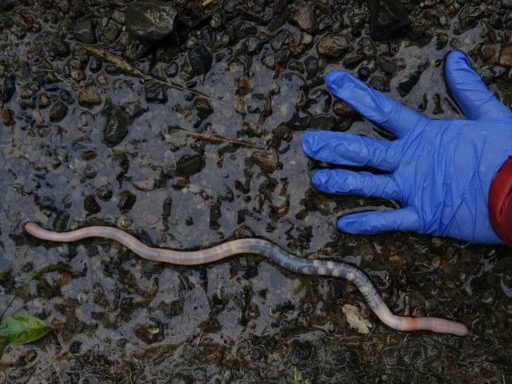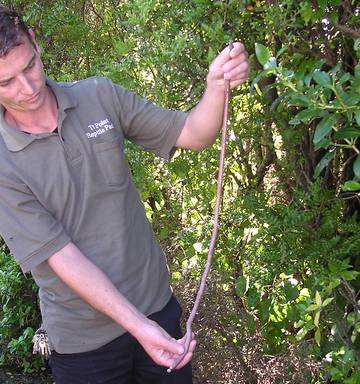Aucklanders, next time you go for a walk in the forest, spare a thought for what might be living just below your feet. For instance, there’s a giant earthworm that grows to over 1 metre long and glows in the dark. It’s the stuff of science fiction – but it’s real! It’s commonly known as the North Auckland worm or, if you prefer, Anisochaeta gigantea (formerly Spenceriella gigantea).
The ‘gigantea’ bit speaks for itself. But its size isn’t the only amazing thing. It is reported to give off a bright orange-yellow light at night.

No-one knows exactly how big our giant native worm grows – we just know that they get to at least 1.4 metres long, maybe 2 centimetres in diameter. Being long, soft-bodied and underground critters, it’s not often anyone finds an intact specimen.
A. gigantea lives in native forests, creating deep tunnel systems a few metres below the leaf litter of the forest floor and even though they glow fluorescently, they rarely come to the surface and are hardly ever seen. The surface isn’t a great place to be if you have no way of defending yourself and you’re a worm-eating bird’s ‘dream come true’! Just imagine a kiwi trying to guzzle down one of these!
Earthworms don’t have eyes, so although North Auckland worm fluoresce, they can’t actually see each other – and being underground, no-one else can see them either. So why the giant worms bother to glow is just one of the many mysterious things about them.
Walking in the forest after very heavy rain may be your best chance of seeing one. If the rain is torrential and their burrows fill with water or block up with mudslips, the secretive giants may be driven to the surface to avoid drowning. They don’t have gills (or lungs) and need to breathe oxygen through their skin – just like the common introduced earthworms that appear on your lawns and paths in wet weather.

One odd fact about A. gigantea is that it has twice as many hairs as ‘normal’ earthworms and apparently feels ‘unshaven’ – so it’s a hairy, glow-in-the-dark, giant earthworm – the more you learn the stranger it gets. But actually, even ‘normal’ earthworms are a lot more impressive than you might think.
The earthworms we commonly see in compost bins (tiger worms) and gardens are introduced earthworms from Europe. In the farmland, gardens, parks, city lawns, and pastures of New Zealand, the earthworm populations consist of a small group of introduced species, which belong to the family Lumbricidae. In native forests and tussock grasslands the native earthworms dominate, all of which belong to the family Megascolecidae (including A. gigantea).
In total, New Zealand has at least 171 species of native earthworms and 23 non-native species.
The North Auckland worm isn’t our only glow-in-the-dark native worm. The native subsoil species Octochaetus multiporus is also bioluminescent. This earthworm is found in the soil under native forests, tussock grasslands, and pastures.
Native earthworms are mostly confined to areas where the soil is disturbed less often – forests, old gardens, hills and mountains – although they were once more widespread. There are 36 known native species that live in forest litter. Seven species have been recorded from Stewart Island. As well as North Auckland’s A. gigantia, several other native species grow to 30 centimetres or more.
Kiwi, kingfishers, robins, brown teal and paradise shelducks all eat earthworms – and so do our giant snails. The endangered land snail Paryphanta busbyi busbyi, from Northland’s Aupōuri Peninsula, is nocturnal, and eats mainly earthworms.
So how many worms are out there? When you walk in the forest it tends to be the birds and perhaps the above-ground invertebrates that get noticed. But scientists have calculated that in our native forests the weight of (native) earthworms is greater than that of all other animal groups in the area, including birds and mammals. That’s a lot of worms!
It’s a similar story in grazed, fertile pastures, where the average weight of (introduced) earthworms in some of New Zealand’s best agricultural soils ranges from about 640 to 3,000 kilograms per hectare. Imagine what 3,000 kilograms of earthworms would look like. There may be up to 1,000 earthworms per square metre, or 10 million per hectare.
As they move through the soil, the worms mix the humus into deeper soil. In addition, after passing through the gut of an earthworm, the soil is enriched in nitrogen, phosphorus, potassium, and other essential plant nutrients. The amount of soil that passes through the digestive systems of lumbricid earthworms living under our pastures can be massive – up to 100 tonnes per hectare per year.
Unlike the introduced species, native earthworms are highly specialised inhabitants of forest soils. Only a few species seem to be able to survive in open country habitats.
There are three types of native worms – those that live in the leaf litter, topsoil, and subsoil species. The leaf litter species live within the layers of forest litter, where they feed on the decaying plant material. Topsoil species make burrows in the topsoil, but forage for food at or near the surface, in the leaf litter. Subsoil species, including the North Auckland worm, inhabit organic-mineral zones of the soil and feed mainly on soil and dead roots. They make extensive burrows in the subsoil, ingesting the soil as they move along.
There are two ways that topsoil and subsoil earthworms can dig their burrows.
In the first method soil is swallowed and then cast either at the soil surface or in natural cracks and cavities in the soil and in deserted burrows. In the second method the front end of the body is extended and inserted in spaces between the soil particles and then, by contracting the longitudinal muscles, the body is expanded laterally, compressing the soil to form a burrow.
Usually burrowing consists of a combination of these two methods, the swallowing method in more-compact soils and the stretch and expand method in less-compact soils. As a burrow is formed it is lined with slime and so has smooth walls firmly compacted by the lateral pressure applied during its construction.
Subsoil earthworms such as the North Auckland worm are usually large, sluggish, and unpigmented. Their extensive burrows extend both laterally and vertically in the subsoil and occasionally go up into the topsoil. Burrows of A. gigantea have been found that are about 20 mm in diameter and still continuing downwards at a depth of 3.5 metres. Who knows how far they ultimately go…
Oddly, given their name, not all earthworms live beneath the earth.
Earthworms are often found under logs and stones, under the bark of dead trees, in rotting logs, and in the litter of epiphytes in the axils of branches of trees. Most of these are species normally found in leaf-mould or topsoil, but one, Megascolides suteri, is almost always found in rotting logs and is able to digest decaying fragments of wood. So really it’s more of a ‘woodworm’ than an ‘earthworm’.
There are even earthworms living in our sub-Antarctic south. Ten earthworm species that have been recorded from the subantarctic Auckland Islands have all been found under logs and stones rather than underground, probably because most of the ground there is covered with acid peat (pH3·6-4·6) and that makes it an undesirable habitat for them.
All of which shows that Aotearoa’s earthworms aren’t quite as ‘ordinary’ as we might think. And for anyone living in the north of the North Island, there may be some fairly extraordinary – not to mention glowing – giants of the earthworm world lurking deep beneath their feet.
By the way, A. gigantia, the North Auckland worm is rare – but no-one knows exactly how rare. Under both the New Zealand Threat Classification System and IUCN Redlist it is classed a “Data Deficient”. So if you see one, take a photo – and don’t forget to measure it. Maybe they grow to more than 1.4 metres – who knows?

